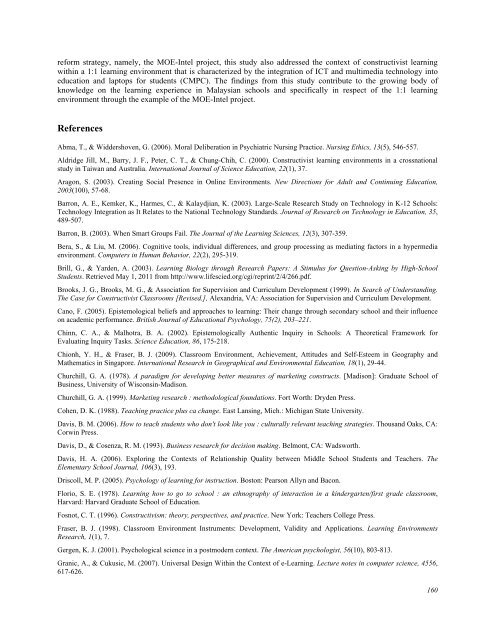October 2011 Volume 14 Number 4 - Educational Technology ...
October 2011 Volume 14 Number 4 - Educational Technology ...
October 2011 Volume 14 Number 4 - Educational Technology ...
Create successful ePaper yourself
Turn your PDF publications into a flip-book with our unique Google optimized e-Paper software.
eform strategy, namely, the MOE-Intel project, this study also addressed the context of constructivist learning<br />
within a 1:1 learning environment that is characterized by the integration of ICT and multimedia technology into<br />
education and laptops for students (CMPC). The findings from this study contribute to the growing body of<br />
knowledge on the learning experience in Malaysian schools and specifically in respect of the 1:1 learning<br />
environment through the example of the MOE-Intel project.<br />
References<br />
Abma, T., & Widdershoven, G. (2006). Moral Deliberation in Psychiatric Nursing Practice. Nursing Ethics, 13(5), 546-557.<br />
Aldridge Jill, M., Barry, J. F., Peter, C. T., & Chung-Chih, C. (2000). Constructivist learning environments in a crossnational<br />
study in Taiwan and Australia. International Journal of Science Education, 22(1), 37.<br />
Aragon, S. (2003). Creating Social Presence in Online Environments. New Directions for Adult and Continuing Education,<br />
2003(100), 57-68.<br />
Barron, A. E., Kemker, K., Harmes, C., & Kalaydjian, K. (2003). Large-Scale Research Study on <strong>Technology</strong> in K-12 Schools:<br />
<strong>Technology</strong> Integration as It Relates to the National <strong>Technology</strong> Standards. Journal of Research on <strong>Technology</strong> in Education, 35,<br />
489-507.<br />
Barron, B. (2003). When Smart Groups Fail. The Journal of the Learning Sciences, 12(3), 307-359.<br />
Bera, S., & Liu, M. (2006). Cognitive tools, individual differences, and group processing as mediating factors in a hypermedia<br />
environment. Computers in Human Behavior, 22(2), 295-319.<br />
Brill, G., & Yarden, A. (2003). Learning Biology through Research Papers: A Stimulus for Question-Asking by High-School<br />
Students. Retrieved May 1, <strong>2011</strong> from http://www.lifescied.org/cgi/reprint/2/4/266.pdf.<br />
Brooks, J. G., Brooks, M. G., & Association for Supervision and Curriculum Development (1999). In Search of Understanding.<br />
The Case for Constructivist Classrooms [Revised.], Alexandria, VA: Association for Supervision and Curriculum Development.<br />
Cano, F. (2005). Epistemological beliefs and approaches to learning: Their change through secondary school and their influence<br />
on academic performance. British Journal of <strong>Educational</strong> Psychology, 75(2), 203–221.<br />
Chinn, C. A., & Malhotra, B. A. (2002). Epistemologically Authentic Inquiry in Schools: A Theoretical Framework for<br />
Evaluating Inquiry Tasks. Science Education, 86, 175-218.<br />
Chionh, Y. H., & Fraser, B. J. (2009). Classroom Environment, Achievement, Attitudes and Self-Esteem in Geography and<br />
Mathematics in Singapore. International Research in Geographical and Environmental Education, 18(1), 29-44.<br />
Churchill, G. A. (1978). A paradigm for developing better measures of marketing constructs. [Madison]: Graduate School of<br />
Business, University of Wisconsin-Madison.<br />
Churchill, G. A. (1999). Marketing research : methodological foundations. Fort Worth: Dryden Press.<br />
Cohen, D. K. (1988). Teaching practice plus ca change. East Lansing, Mich.: Michigan State University.<br />
Davis, B. M. (2006). How to teach students who don't look like you : culturally relevant teaching strategies. Thousand Oaks, CA:<br />
Corwin Press.<br />
Davis, D., & Cosenza, R. M. (1993). Business research for decision making. Belmont, CA: Wadsworth.<br />
Davis, H. A. (2006). Exploring the Contexts of Relationship Quality between Middle School Students and Teachers. The<br />
Elementary School Journal, 106(3), 193.<br />
Driscoll, M. P. (2005). Psychology of learning for instruction. Boston: Pearson Allyn and Bacon.<br />
Florio, S. E. (1978). Learning how to go to school : an ethnography of interaction in a kindergarten/first grade classroom,<br />
Harvard: Harvard Graduate School of Education.<br />
Fosnot, C. T. (1996). Constructivism: theory, perspectives, and practice. New York: Teachers College Press.<br />
Fraser, B. J. (1998). Classroom Environment Instruments: Development, Validity and Applications. Learning Environments<br />
Research, 1(1), 7.<br />
Gergen, K. J. (2001). Psychological science in a postmodern context. The American psychologist, 56(10), 803-813.<br />
Granic, A., & Cukusic, M. (2007). Universal Design Within the Context of e-Learning. Lecture notes in computer science, 4556,<br />
617-626.<br />
160

















